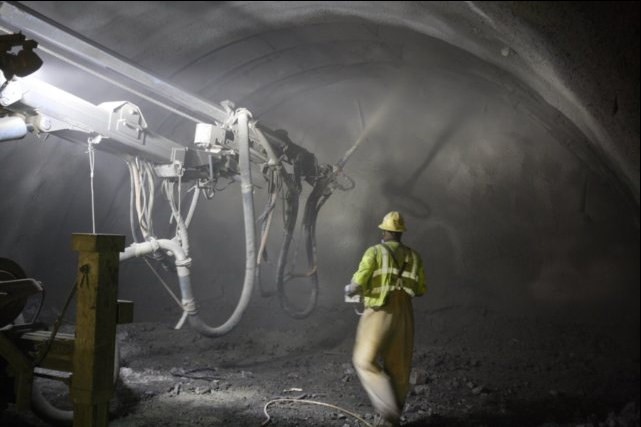
How Shotcrete Contributed to the New Austrian Tunnelling Method

Arguably the most widely used underground tunnelling technique employed today is the New Austrian Tunnelling Method (NATM). Developed in the 1960’s in Austria by Ladislaus von Rabcewiz, Leopold Muller, and Franz Pacher, the main principle of this method is to use geological stress of the surrounding rock mass to stabilise the tunnel itself. What’s interesting is that the success of this ground-breaking technique can be attributed to the technical advances in shotcrete technology.
How does the NATM approach work?
The NATM approach integrates the principles of the behaviour of rock masses under load and monitoring the performance of underground construction during construction. This system of tunnel engineering is not a set of specific excavation and support techniques, but rather as a ‘design as you monitor’ approach to tunnelling based on observed convergence and divergence in the lining along with prevailing rock conditions. Being regarded as the ‘gold standard’ of building and evaluating tunnels, this economical technique seeks to maximise the terrain’s inherent resistance and support capacity.
Not only does this method achieve substantial savings in both material and labour costs, it also displays great resistance to the geological pressures experienced in earthquake-prone areas. Rather than supporting the tunnel immediately without giving it time to deform (as seen in the German and Belgian approaches), NATM allows the rock mass to deform before stabilising the tunnel with shotcrete which leads to significant material savings. This sequential method was celebrated when it was first introduced in the 1960’s due to the significant cost savings and increased security it offers.
Once the rock mass has deformed, the resulting tunnel is covered with a layer of shotcrete which is more efficient than cast-in-place as it doesn’t require substantial formwork and additional labour. This shotcrete layer increases the internal cohesion of the rock mass and reinforces the support ring as a temporary and/or final lining, depending on the project specifications. Using an observational approach, NATM adapts the tunnel support design to the geological requirements.
What are the advantages and disadvantages?
While the NATM approach is widely considered to be best practice in the industry, there are some downfalls to using this method. The following describes some of the advantages and disadvantages with NATM.
Advantages
- Flexible – support is provided as required according to the ground conditions
- Safe – capable of dealing with locally unexpected ground condition
- Economical – support is only provided if required by the ground conditions
- Adaptable – allows for multiple heading operations concurrently and optimising equipment and crews
Disadvantages
- High level of coordination, communication, and cooperation is required
- Lower production rates
- Interruptions in excavation and support works
What about the name?
There is a bit of confusion surrounding the name and consequently new terms have been created for specific aspects of the NATM approach as it became more widespread. As the approach is actually a design philosophy rather than a construction technique, some engineers use the term NATM whenever proposing shotcrete for initial ground support in an open-faced tunnel. When referring to ‘shallower tunnels’, many industry experts prefer to use ‘Sequential Excavation Method’ or ‘Shotcrete Method’. In London, the approach is referred to as ‘Sprayed Concrete Lining’ while in Japan, the preferred name is ‘Cross Diaphragm Method’.
Despite the lack of consensus regarding the name, NATM has proved to be the most effecting tunnelling approach that will be used for many years to come. If you require any additional information about the NATM approach, or you’re interested in using shotcrete as ground support for your next project, get in touch with the experts at Evolution Shotcrete by phoning 07 5561 8885.


